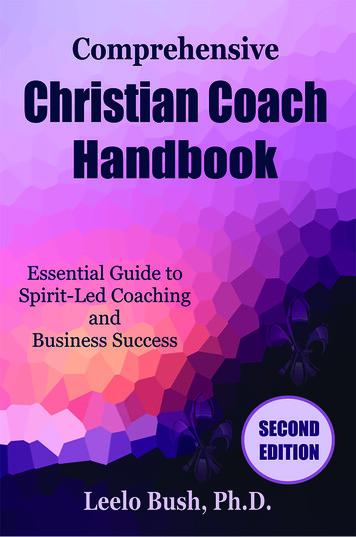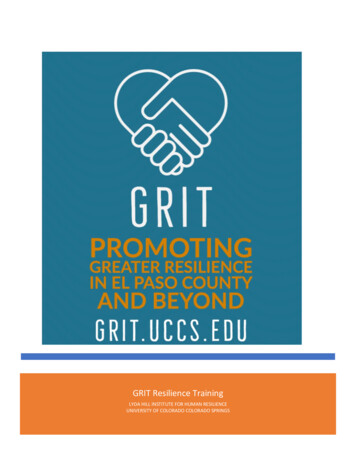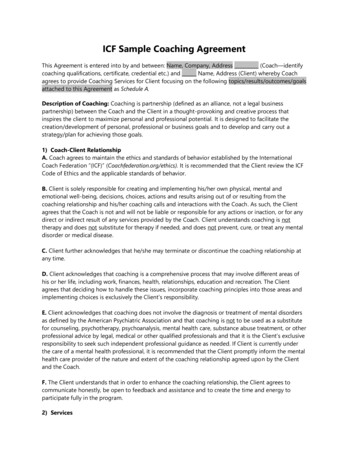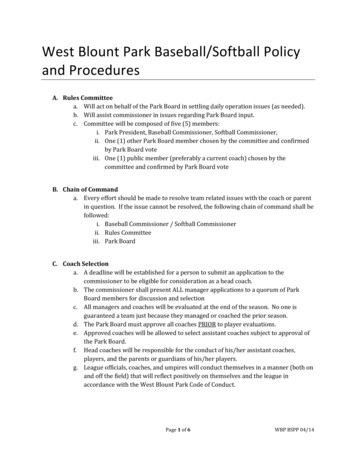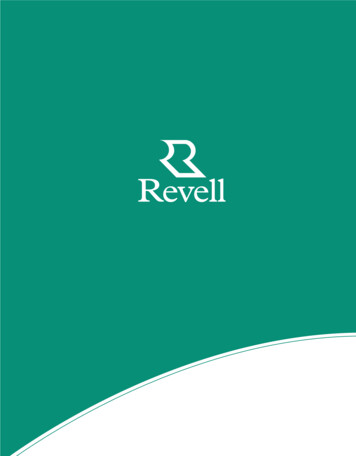
Transcription
2016Financial Coach HandbookFINANCIAL STABILITY & CAREER SERVICES (FSCS)MARK HAMM, FSCS SUPERVISORCATHOLIC CHARITIES OF DALLAS, 9451 LBJ FREEWAY, SUITE 100, DALLAS, TX 75243
OverviewFinancial Stability and Career Services is an innovative program where our team of Financial Coachespartner with our clients to better their financial situations—over the long term.Our program's mission is to improve the quality of life for individuals and families by incorporatingintegrated services- financial coaching and education, job services and career enhancement, and incomesupports. We are Financial Coaches; we offer a relaxed and non-judgmental environment where clients canopen up about their situations, no matter what financial position they are in.We treat our clients as naturally creative, resourceful, and whole, and we make sure we level the playingfield from the first encounter. We are tasked with empowering our clients to elicit the skills and creativitythat they already possess, while simultaneously building them up through education, training, andresponsible coaching. For a client, this involves: Setting goals that are specific, measurable, attainable, realistic and time-bound Seeking out jobs with livable wages Enrolling in job skills training that will yield careers with a livable wage Decreasing expenses and learning about healthy spending habits Education in ESL, GED, and beyond Accessing income supports such as benefits, food, and financial tools Support and motivation to do all of the aboveThe Coach and client form a partnership, and the outcomes are fluid and based on the goals of the client.We act as conduits for resources and opportunities, and serve as collaborators to the client for as long asneeded to obtain financial stability. We pride ourselves on being able to work with all types of clients fromall backgrounds, both low and median income levels.We are less focused with outputs, and more involved with client outcomes. We concentrate on multiplefinancial data points that are direct measures of self-sustainability. We realize that real growth andbehavioral change doesn’t occur in a short amount of time, but only after a trusting and long-termrelationship is established, and healthy habits become routine.
IntroductionJ. Michael Collins, a professor at the University of Wisconsin-Madison, describes financial coaching as a shifttoward engaging people in becoming more active managers in their financial lives. It is not about teachingspecific personal finance content, but rather helping people to form goals, take actions, and follow through withthe behaviors in which the clients categorize as important. Coaching is not the enforcement of a rule or method.However, coaching methods do share common processes that engage clients in developing patterns of healthybehaviors.Financial Coaching applies techniques from positive psychology, a branch of psychology focused on improving lifeexperiences. Coaching techniques have been used in all careers and professions and are often key aspects ofmentoring and motivational roles. Non-profit programs have been applying coaching techniques to financialcapability programs under the assumption that the real change is only going to occur when the client is in controland ready to change their situations.What is your role?As a Financial Coach, you are expected to have knowledge on a wide array of financial topics, but do not take thison as an unmanageable challenge. As you continue to coach more and develop your skills, you will become moreaware of all of our client’s situations and obstacles, and the varying solutions and strategies associated with each.The goal of your position is to help families become economically self-sufficient through coaching, not casemanagement. You are not a Certified Financial Planner and should not be giving advice on financial decisions.You present options and it’s the client who chooses the path.The Coach is responsible for some class instruction and education workshops, but is mostly involved in workingwith clients in 1-1 sessions. The Coach also assists clients in regards to their housing needs, throughrenter/homebuyer education, foreclosure prevention services, and pre-purchase counseling. Coachesdemonstrate professional boundaries without offering financial advice to clients.No matter how a client finds his/her way into our organization, it is your responsibility to provide clear andconsistent service. Ideally, each Coach on our team would provide equal service in regards to delivery, clientrapport, and documentation of the visit. But because we all have varying approaches, we must task each Coachto use the guidelines listed in this handbook. In this way, we will ensure that you are coaching consistently andare providing the client the environment and framework needed, for making lasting changes in their lives.You will occasionally encounter areas that you are not confident in, but do not worry. The Client-Coachrelationship is a journey, and you are both in it together. There is nothing wrong with admitting you do not havethe answers to specific questions they may present. Remember, it’s the clients who have their own answersyou’re tasked with challenging them to find them.Please see the Coach Job Description in the appendix.What are we measuring?We are responsible for collecting baseline data for: Employment statuso Wage and hours workedo Employment placement date (if applicable)o Employment Retention (if applicable) At 30, 90, and 180 day anniversaries of job placement
Enrollment In Job Skills Training (if applicable)o Completion of Job Skills TrainingMonthly Net Incomeo To include all income sources and all expensesTotal amount of savingsEstimated value of assetsCredit ScoreAmount of DebtFinancial Capability ScaleAt minimum, these data points should be reviewed at the initial session and the 30, 90, and 180 dayanniversaries. Each coaching relationship is unique, so communication and follow-ups may occur morefrequently.Prior to the coaching sessionIdeally, you as the Coach would have had time to prepare any material and questions ahead of time. Forscheduling initial coaching sessions, it is wise to gather as much information as possible without getting intocoaching. This may be done over the phone, in-person, or through emails. You should find out information soyou can gauge what needs to happen to establish a solid alliance with this person. It would be best to know thewho, what, when, where, and why- all before the initial session.Example: John was a walk-in seeking employment. I informed him I was booked for the day, but could doan intake with him and schedule our first coaching session the following day. John has been unemployedfor a few months and is wanting to find work. He states he will take any wage but would love somethingfor 13 an hour. He lives in 75243 and takes the DART. During intake, John indicated he is lackingconfidence in his interviewing skills and has always struggled with money and holding down a job. Wescheduled our first session together at 6/23 at 1pm at 9451.(You should include this description in the Outlook Calendar event)Prior to the initial coaching session, the Coach should make an outline of the issues and discussion points; thiswill help bring the session back on track in case it gets off topic. The client will often be looking for advice,guidance, and ideas, so it is pivotal that you do your homework and plan prior to the session. For example, thiscould include: Familiarizing yourself with their work history and projected career fieldResearching housing options for the clientsResearching job skill training options or community college programs relative to their goalsWhen the Coach comes into the coaching session with a decent understanding of relevant topics, theconversation and dialogue will be much more smooth and consistent.The Initial Coaching SessionThe initial coaching session can be labeled the “Discovery Session.” This session establishes the professional tonefor the Client-Coach relationship and is crucial to all consecutive communication. The most important aspect ofthe Discovery Session is to create relationship and rapport with the client and to design the alliance.
It is important to remember that during the first coaching session, the time belongs to the client. Aside from themandatory forms and data you must acquire, the client should be leading the discussion. With this being said, itis crucial that you don’t allow the session turn into a speech, where the client is simply talking at you, where theyare telling you what they have told countless others about their struggles. It is imperative that you incorporatepowerful questions that may enable to the client to think differently about their situation. Powerful questionsare intended to stimulate reflection of their past and the related behaviors, and they may invoke new thoughtsand ideas. We will discuss more about those later in the handbook.The following intake forms are mandatory at the initial coaching session. Some Coaches choose to have theclient fill them out in the beginning, others do it at the end. These completed and signed documents will need tobe electronically attached to the Financial Status Check in ETO.1. FSCS Enrollment Form2. Client Bill of Rights3. Client – Coach AgreementBeginning the dialogueI often begin the session with an open inquiry:Please tell me about yourself. What brings you in here today? How are you today?This opens it up and helps you gauge the level of interaction that the client is going to initially provide. I provideabout 5-10 minutes just to get the conversation started. It is not necessary to rush into this relationship- wedistinguish ourselves from other organizations in that we are privileged to be there with the client, and to createtrust, you have to get to know the client.It is your duty as a Coach to slow things down. You may have blocked out 1-2 hours for this client, and neitherparty should try to rush through this experience. We use the phrase “dance in the moment.” In the coachingrelationship, every single experience is an opportunity to co-create, to grow, to evolve. When you dance in themoment, life becomes an adventure because each party involved is open to the full range of human experience.Periods of silence are a natural part of the coaching relationship and neither party should rush to fill the quietduring discussion and reflection. Often we are concerned that we will be caught unprepared or without theanswers. But when you allow yourself and your client to dance in the moment, new thought processes mayarise.If you are new to coaching and need a road map, you can use the GROW Model of Coaching to help guide thecoaching session. This provides a good framework to base your coaching sessions upon. Our Coaches often bringa copy with these to the session to ensure they stay on track and to remind them of the different elements.Building a co-active relationshipIt is important that you build rapport with your client. Rapport is a close and harmonious relationship in whichpeople understand each other’s feelings or ideas and communicate well. Think of rapport as speaking freely andopenly with your client and where the conversation isn’t one sided.Rapport can be built through active listening. Active listening is not just listening and retaining the words thatare being said, but more about understanding the complete message that is being sent. To be a fully engagedactive listener, you have to reflect on your own communication styles. If you have difficulty learning through
auditory means, it may be necessary to clearly restate your interpretations of the situation, using specificquestions to ensure you are capturing their meaning.A key aspect of coaching is ensuring that the client is the one driving the process. A Coach needs to get theclients input on how to resolve financial or employment issues. Do not impose a solution or goal on the client,but guide them as necessary to healthy tactics or methods to better their situations. Furthermore, inquire aboutthe specific steps. It may seem silly to ask about the first step to opening a savings account, but having the clientsay the steps aloud will positively impact the learning process.You should imagine the coaching relationship as a triangle, where you and the client are on separate sides, bothdriving forward to the peak at the top. You and the client share equal power in the relationship, and you bothgive power to it. The below diagram was developed by the Central New Mexico Community College.The Coaching RelationshipCoachClientGives objective assessment and observationsCreates the coaching agendaPractices deep listening to fully understand theIdentifies meaningful goalsindividuals’ circumstancesActs as a sounding board, supports possibilities andAssumes full responsibility for decisions anddecision makingactionsFosters shifts in thinking to reveal freshTakes courageous action in alignment withperspectivespersonal goals and aspirationsMaintains professional boundaries and adheres to Utilizes the tools, concepts, and principles providedethical standardsby the coach Central New Mexico Community College, 2013Who owns the coaching session?It is important that the client take responsibility for the coaching relationship right from the beginning. You needto make sure your agreements are clear and that the client has ownership for the relationship. Remember thatyou are a professional; do whatever is needed to create an environment of professionalism with clearexpectations.
Most of the clients you encounter may be seeking employment, and you may be aware of that before they walkthrough the door. FSCS is different than other social service agencies, and vastly different from a staffing agency.The client’s goal may be to “get a job.” There is much more to it than that! What is behind the need for a job?Where does the passion lie? What are the core values of your client? It is your responsibility to find this out, andalways remember, if you don’t ask, they may not tell.It is the Coach’s duty to guide this client-driven process by engaging the clients in active listening and powerfulquestions. The Coach empowers each client to be the expert on her specific need, goal, and choice, and to setreasonable goals and timelines. The Coach must respect the client’s decisions and goals and stay true to theunique and individualized plans that the clients create. Although the client is the one who creates the milestones,it is the Coach who establishes the framework for accountability as the steps towards the goals are carried out.Powerful QuestionsOne of the key skills to being an effective Coach is learning how to ask the right questions. When timed correctly,powerful questions put a halt to evasion and confusion. By asking the powerful question, the Coach invites theclient to clarity, action, and discovery at a whole new level. These are generally open ended questions thatcreate greater possibility for expanded learning and a fresh perspective.Well timed powerful questions cause clients to think on their own. We believe our clients to be intelligent andwell-informed people and that they are the ones with the answers to their situations. The Coach should not steerthe client to a solution, but use powerful questions to spur new thoughts that the client may not have come upwith yet.Asking the right coaching questions gives someone who’s busy and competent the space in which to step backand examine themselves. The function of a coaching question is not to demonstrate a Coach’s supreme creativityor outstanding intelligence, but to really help the client focus on their issues with a creative perspective. When aclient cannot easily find answers or solutions, it is wasted time to search in the same way in which the client hasalready done. It is useful however, to help the client reconfigure or reboot their way of defining the issue, ofconsidering the problem, or of visioning an ambition. (metasysteme-coaching.edu)Please refer to this list of powerful questions developed by Co-Active Coaching Institute.Spending PlanThe Spending Plan, or budget, is a pivotal piece in the coaching session. This is a required form and is necessaryon the initial visit. The Spending Plan is to be updated throughout the relationship with the client when changesto incomes and expenses arise. You should utilize your active listening skills, because you will likely observe theincome and spending habits of a client when they are telling you their story through the session. When it comesthe time to complete the Spending Plan, treat it like a game, where you are trying to get the most accuratesnapshot of a client’s financial situation, without actually going line-by-line on their bank statement.It is recommended that you fill this out with the client. If you task the client to fill these out alone, it may detractfrom the co-active relationship or allow the client to underestimate their spending behavior. Initially, you will notlikely know the exact spending amounts, but getting the client to present their best estimate and then going fromthere is a great start.All things considered, individuals typically are not open to telling a stranger about their finances. That’s why it’simportant to ease into the financial capturing process. Don’t pressure the client into releasing their income andexpenses until the client is fully aware of our program and the intentions behind it. We are here to help people
tap into their natural God-given talents and abilities, and capturing accurate financial data at the beginning andend of the relationship, as well as throughout the relationship, is a non-subjective way to measure a client’sprogress.Goals Sheet / Action PlanJust like the Spending Plan, another required step in the process filling out the Goals Sheet and Action Plan.Working together, the client needs to establish a realistic and attainable goal, and those goals need to haveidentifiable actions steps. We often use the SMART Goals platform, as it leaves little to chance in terms of thespecifics of the goal. Use the SMART method so the client reduces ambiguity and obstacles to envisioning thegoal and actually taking the first step.It is imperative that the client writes her goals down on her own. With this being said, the Coach and client willhave discussed in detail many specifics and methods behind building SMART goals. When it comes time in thesession to discuss their goals, you have to be exceptionally curious.Many times, the goal is to find employment. Additionally, the clients we see are often seem desperate andwilling to take any type job for any pay. We as Coaches need to dig a little deeper before going further. Forexample, if a client is seeking employment, you should have already asked these questions before filling out theGoal Sheet.An important part of the Coach and client relationship is how to manage the work load outside of the coachingsessions. The vast majority of the action steps are to be completed by the client. Remember, the outcomes andchanges occur in between sessions without the presence of the Coach. There are some action items that arewell-suited for Coaches. These include leveraging partnerships between employers/organizations to findopportunities, researching items that may be completely foreign to the client, or researching topics that wouldbenefit the Coach’s knowledge base and future coaching relationships.One of the hardest aspects of our jobs is how to keep our clients accountable. Often times, Coaches find itdifficult to keep clients actively engaged in between coaching sessions. This is because people tend to get caughtup in hectic flow of their lives, while allowing their financial goals to sit idle. Over time, you will develop yourown methods for keeping clients accountable. Here are some tips to keep your clients engaged.Documenting the Coaching SessionYou are required to keep clear and consistent notes on your client relationship. At minimum, we maintaincontact with our clients for six months. During this span, you are required to do follow-ups at the 30, 60, and 180day anniversary dates. For some clients who have a goal to obtain employment, these follow-up calls may just bechecking in to review any changes to their new job or wages. More in-depth coaching relationships may yieldmuch more frequent coaching sessions where on-going goals are touched upon.Keeping detailed and accurate notes is not only a good way to keep you organized and engaged with your clients,but it’s also a requirement for oversite from your management and funders. For each initial coaching session, inaddition to their financial data, your case notes should include the following:1. How client was referred to you2. Why the client initially came in3. Summary of client. To include:a. Work historyb. Their support network
c. Barriers the client may haved. Attitude of the cliente. What the client has done already to better their situation4. Summary of action plan and clients’ homework5. Coach’s homework6. Arrangements for the next coaching sessionFor follow-up coaching sessions, your notes should include at minimum:1. Was session scheduled or spur-of-the-moment2. What was discussed:a. Were action steps completed?b. Changes in data?c. New discoveries?3. Arrangements for the next meetingAs a Coach, you need to document every instance where you communicate with your client. Additionally, eachinteraction needs to be annotated whether it was by phone, email, or in-person, as well as how long eachinteraction lasted. This is part of being a good steward of your time and is also required procedure for manysocial service agencies where funders may audit your work.ConclusionFinancial coaching is still a young phenomenon and many aspects are yet undefined. The intensity of coaching,how long a relationship lasts, and the extent of supports provided to clients can vary dramatically from a fewsessions in a short period to many sessions over several months or even years.Financial coaching is not designed to be a therapeutic in nature. It more closely supports adherence to positivefinancial behaviors and the goals set out by the client. There are no common metrics across financial coachingprograms, but all are based in positive psychology, realistic goal setting, and a strong partnership focusing on thechanging of financial behaviors.Whether the relationships are short or long in duration, financial coaching is focused on positive language,forward thinking, and long term behavioral change. Be fully present with your clients and remember to take eachsuccess as it comes, and to celebrate together along the way.
Appendix A – Intake Form-Page 1RETURN
Appendix A – Intake Form-Page 2
Appendix B- Bill of RightsRETURN
Appendix C- Client – Coach Agreement RETURN
Appendix D- Outlook Calendar Event for Coaching SessionRETURN
Appendix E- Coach Job Description, page 1 RETURN
Appendix E- Coach Job Description, page 2RETURN
Appendix F- Employment Survey, page 1RETURN
Appendix F- Employment Survey, page 2RETURN
Appendix G- Spending Plan, page 1RETURN
Appendix G- Spending Plan, page 2RETURN
Appendix H- Goals SheetRETURN
Appendix I- Action PlanRETURN
Appendix J: Financial Capability ScaleRETURN
Appendix K: SMART GoalsRETURN
RapportAppendix L: Building RapportRETURN8 Ways to Build Rapport with your clients1. Talk about timea. Inform the client of how long coaching sessions last and let them know that they are in control. A clientmay be more relaxed knowing that the session has a start and end time2. Use your nonverbal communicationa. You should look as nonthreatening as possible. This means SMILE!b. Keep your head level so it doesn’t appear that you are looking down at themc. Keep a slight angle to the other person- don’t sit directly in front of them, toe to toe3. Speak slowlya. Speaking fast may imply that you are excitedb. Purposely slow down your delivery and take pauses for clients to absorb the content of what you havejust said4. Be empathetica. Place yourself in the client’s shoes; have you ever been in a rough spot in your life? Was it difficult toreach out for help? What feelings did you have? Shame? Remorse? Hopelessness? It’s not a Coach’sduty to feel pity, but to provide perspective to the client and collectively create solutions5. Ego Suspensiona. When two individuals engage in conversation, they each typically wait for the other party to completetheir statement, so the other person can then tell their own story on a related topic- and typically thesecond story is aimed at being more interesting. DO NOT DO THIS!b. You should practice good ego suspension and encourage the client to talk more about her story. Refrainfrom jumping in with your own stories or anecdotes and be extremely curious about theirs, and digdeeper than anyone else has before6. Validate your clienta. Listening: you are there to listen to the client--- you aren’t there to tell your story or impose your ideasi. By listening and not talking, it makes it easier to remember details about the clientb. Be thoughtful: Thoughtfulness is wanting others to be happy and anticipating their desiresi. Most of the time, you don’t realize that a person exhibits a high level of thoughtfulness, but allyou know is that you really like the person c. Acknowledge and respect their thoughts and opinionsi. The best way to get someone to do what you want them to do is to have them come up with theidea. The best way to have them come up with your idea is, no surprise, to honestly understandthe other person’s point of view and then build upon that base with your ideas.7. Ask . How? When? Why?a. When your client supplies more words and thoughts, utilize that content and continue to ask openended questions about the same topics.i. You shouldn’t be thinking about what you are going to say nextii. You shouldn’t be thinking about how the client is wrongiii. If you are really listening, then asking open ended questions based on the content of what theyare saying should be pretty easy8. Connect with quid pro quo (this for that)a. When working with clients that are introverted or guarded, it may be helpful to put forward someinformation about yourself to help alleviate the issue.i. Example: I also fell on hard times a couple years back- I went a little overboard at Christmas andmaxed out one of my credit cards. In January, I didn’t know how I was going to pay it down andfelt like I was drowning.
Appendix N: Client AccountabilityRETURN
Appendix O: GROW Model of CoachingRETURN
Appendix P: Powerful Questions, page 1rful QuestionsAnticipationWhat is possible?What if it works out exactly asyou want it to?What is the dream?What is exciting to you aboutthis?What is the urge? What doesyour intuition tell you?AssessmentWhat do you make of it?What do you think is best?How does it look to you?How do you feel about it?What resonates for you?ClarificationWhat do you mean?What does it feel like?What is the part that is not yetclear?Can you say more?What do you want?ElaborationCan you tell me more?What else?What other ideas/thoughts/feelings do you have about it?RETURNEvaluationWhat is the opportunity here?What is the challenge?How does this fit with yourplans/way of life/values?What do you think that means?What is your assessment?ExampleWhat is an example?For instance?Like what?Such as?What would it look like?ExplorationWhat is here that you want toexplore?What part of the situation haveyou not yet explored?What other angles can youthink of?What is just one morepossibility?What are your other options?For InstanceIf you could do it over again,what would you dodifferently?If it had been you, what wouldyou have done?How else could a personhandle this?If you could do anything youwanted, what would you do?Fun as PerspectiveWhat does fun mean to you?What was humorous aboutthe situation?How can you make this morefun?How do you want it to be?If you were to teach peoplehow to have fun, what wouldyou say?HistoryWhat caused it?What led up to it?What have you tried so far?What do you make of it all?continued
Appendix P: Powerful Questions, page 2RETURNImplementationWhat is the action plan?What will you have to do to getthe job done?What support do you need toaccomplish it?What will you do?When will you do it?IntegrationWhat will you take away fromthis?How do you explain this toyourself?What was the lesson?How can you make sure youremember what you havelearned?How would you pull all thistogether?LearningIf your life depended on takingaction, what would you do?If you had free choice in thematter, what would you do?If the same thing came up again,what would you do?If we could wipe the slate clean,what would you do?If you had it to do over again,what would you do?OptionsWhat are the possibilities?If you had your choice, whatwould you do?What are possible solutions?What will happen if you do, andwhat will happen if you don’t?What options can you create?OutcomesWhat do you want?If you got it, what would youhave?How will you know you havereached it?What would it look like?PerspectiveWhen you are ninety-five yearsold, what will you want to sayabout your life?What will you think about thisfive years from now?How does this relate to your lifepurpose?In the bigger scheme of things,how important is this?So what?PlanningWhat do you plan to do about it?What is your game plan?What kind of plan do you need tocreate?How do you suppose you couldimprove the situation?Now what?PredictionsHow do you suppose it will allwork out?What will that get you?Where will this lead?What are the chances ofsuccess?What is your prediction?ResourcesWhat resources do you need tohelp you decide?What do you know about it now?How do you suppose you canfind out more about it?What kind of picture do you haveright now?W
Financial Coaching applies techniques from positive psychology, a branch of psychology focused on improving life experiences. Coaching techniques have been used in all careers and professions and are often key aspects of mentoring and motivational roles. Non-profit programs have been applying coaching techniques to financial
